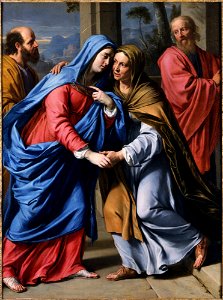Catalogue entry:
philippe de champaigne, a founding member of the académie royale de peinture et de sculpture, was a follower of the jansenist movement, which sought to use art as an aid to meditation and eliminate decorative, sensuous elements. These holy figures are bathed in a raking light representing god’s grace, as they recognize their destinies, the virgin to bear the savior and her elderly cousin, elizabeth, to give birth to saint john the baptist. When mary visited elizabeth to inform her of her pregnancy, she spoke the verses known as the magnificat: "my soul doth magnify the lord" (luke 1:41, 46–55). Joseph and zechariah witness the scene and marvel at god’s plan for salvation. The artist repeated this composition in both full- and half-length formats. One of them was once part of the decoration of a chapel in the church of the oratory in paris. There, the visitation and dream of joseph were on the sidewalls, while the nativity was on the altar. In a narrow chapel, the formula of placing the figures in a shallow, shadow-box-like space would have created an especially theatrical effect. Indeed, the remarkably concentrated narrative, with the restrained gestures of the figures, has affinities with french classical theater of the time. Derived from ancient theater as defined in aristotle’s poetics, seventeenth-century french theater evolved from baroque effects toward a purified and rigorous theatrical practice, in which props were eliminated, objects received euphemistic, noble names, and the individual actor’s tirade carried the plot forward. The meeting of the two women, mary’s words, elizabeth coming toward her like a noblewoman’s attendant in a play, recall theatrical conventions and mirror a pattern that would have been familiar to viewers of the period. Gallery label:
the virgin mary, who has just learned of her pregnancy from the archangel gabriel, greets her cousin, the elderly elizabeth, at the doorway of her house. The formerly barren elizabeth is now six months pregnant with john the baptist. According to the evangelist luke, “when elizabeth heard the salutation of mary, the babe leaped in her womb” (luke 1: 41). Here saints zacharias, husband of elizabeth, and joseph, fiancé of mary, are also present at the visitation. Philippe de champaigne, a follower of jansenism, an augustinian movement in the french catholic church, painted several similar versions of the subject. The scene may have appealed to jansenists because their doctrine denied free will and emphasized god’s grace and predestination. Object Type: painting. Genre: religious art. Date: 1643. Place of creation: France. Dimensions: height: 114.5 cm (45 in); width: 88.5 cm (34.8 in); frame: height: 141.6 cm (55.7 in); width: 112.7 cm (44.3 in); depth: 12.4 cm (4.8 in). Medium: oil on canvas. Collection: Princeton University Art Museum. De Champaigne, Philippe, The Visitation, 1643-48
Loading...
